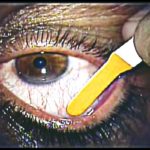Stevens-Johnson syndrome is a rare disorder of the skin and mucus membranes- usually a reaction to a medication or infection. It is regarded as a kind of toxic epidermal necrolysis, in simpler terms, a condition in which dying cells cause the epidermis to separate from the dermis. It is often thought to arise from a hypersensitivity complex where the skin and its mucus membranes are affected. It affects adults more than children, and it is more susceptible to females than in men, with a ratio of 2:1. Without treatment, this rare skin condition could be life threatening. It is accompanied with some distinct symptoms that should be considered before concluding the disease.
Major symptoms including Skin Rash
At the initial stages of Stevens-Johnson syndrome, a person may begin to experience some fever, sore throat and overall fatigue. As it progresses, one will soon begin to have a burning sensation in the eyes accompanied by a persistent cough.
Later on an individual may develop swelling in the face and tongue, with stinging skin pain. The skin pain will soon turn to a purple or red rash within a matter of days or in some cases, hours. With this, patients may experience some blistering on their skin as well as the mucous membranes of the genitals, mouth, eyes, and nose. These symptoms can also be associated with the abrupt shedding of the skin.
One of the noticeable symptoms is the appearance of rash typified by circular inch-wide lesions across the face, torso, hands, legs and soles.
It is recommended that immediate medical attention be sought once any of these combinations of symptoms begin to be experienced. Facial swelling and unexplained skin pain should particularly be clear pointers that something is clearly amiss in as far as the skin is concerned.
What causes the Stevens-Johnson syndrome?
Although this condition is very rare, there are certain factors that are responsible for its development. It can at times be associated with a reaction to a particular drug such as anti-gout medications. Medications that are used to treat seizures and other forms of mental illnesses are also likely to lead to this disorder. Radiotherapy is also a huge contributor to its development. People who are in constant contact with pain relievers such as acetaminophen, naproxen sodium, and ibuprofen increase the chances of their skin having a severe reaction to these drugs.
Risk factors
Aside from the reaction to drugs and medication, there are also several risk factors that increase the likeliness of developing the syndrome. For one thing, infections caused by a virus such as hepatitis, pneumonia and herpes can increase the chances of SJS. One also suffers the risk of having the disorder if they return to drugs that previously had adverse effects on the skin.
A family with a history of having Stevens-Johnson syndrome also faces a huge risk of one of the members having the disorder. There exists a related condition, toxic epidermal necrolysis, which if a family member has it, chances are that, if no proper care is taken, a close member of the same family will have the SJS as well.
Another risk factor is having a weakened immune system. HIV/AIDS has been known to destroy the body’s ability to fend off diseases and thus may increase the likeliness of having SJS. Furthermore, the fact that HIV is a virus infection makes it an individual more likely to succumb to the syndrome.
In some rare situations, having a vulnerable gene can play the risk factor. If one has a gene called the HLA-B 1502, they are very likely to have seizures in future. Medications that are used to treat these seizures will eventually increase the risk of Stevens-Johnson syndrome.
Treatment and life expectancy
The Stevens-Johnson syndrome should be treated as a dermatological emergency and as such, treatment should be sought immediately there are distinct symptoms. Treatment would often require the patient to be admitted to hospital in the burn or intensive care unit. The first and probably most important step in treatment is to discontinue any form of medication that one may have been under prior to the hospital visit.
An eye specialist should be consulted for patients whose infection has reached the eye. As the person continues to heal, the blisters could be cooled with wet, cool and soft cloth. Fluid replacement is also an essential part in the healing process as the skin may be depreciating as a result of lack of fluids in the body. A nasogastric tube may be placed in the patient’s nose and into the stomach to help increase the body fluid levels.
Some of the most common medications used to treat SJS include antibiotics, painkillers and those used to treat skin inflammation. If the condition was initially caused by an underlying factor, and this factor is eliminated completely, then one can grow a new skin-set on the affected areas within days. If the effects were too severe, the healing and growth of new skin may take significantly longer, even months.
If treatment has proven effective and any underlying factors causing SJS are eliminated, one can be able to grow the skin back and if proper care and medication is taken, an individual can lead a fairly normal long life. If treatment begins when it is too late, however, the chances of leading a normal life or even surviving stands at a 50-50.

